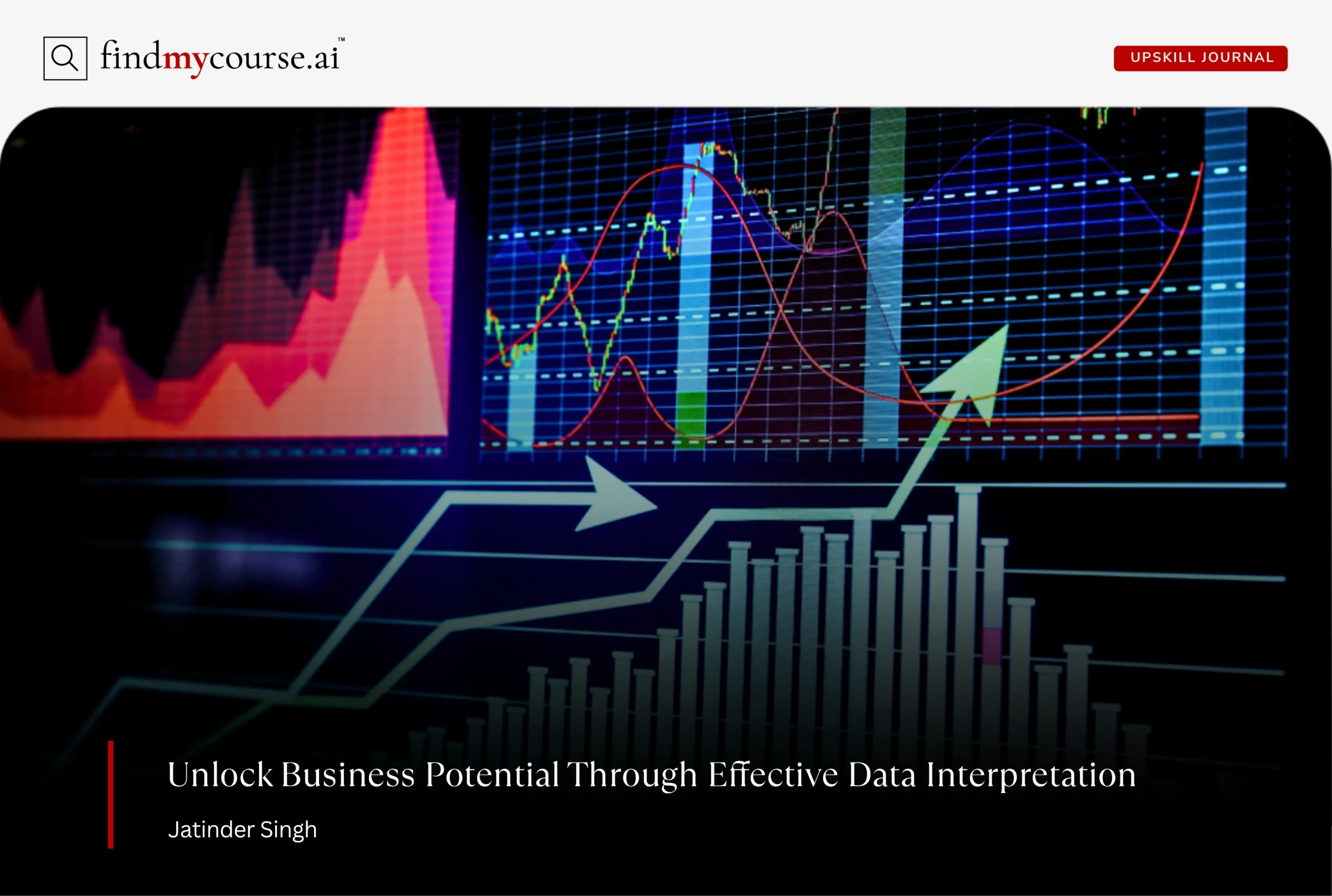Every day, companies gather massive amounts of information—sales figures, customer reviews, and financial metrics. But collecting data isn’t the same as understanding it. Data interpretation bridges that gap by transforming business data into meaningful insights that guide smarter decisions. It helps leaders uncover patterns, identify opportunities, and make confident, evidence-based choices. In a world driven by information, those who can interpret data effectively gain a powerful competitive edge. Whether you’re managing a team or aiming to upskill in analytics, mastering data interpretation is a skill that turns information into impact.
Understanding Business Data Interpretation
Business data interpretation is not just about analysing numbers—it’s about understanding the story behind them. It’s how companies transform raw data into insights that reveal what’s working, what isn’t, and what opportunities lie ahead.
For instance, a sudden increase in website traffic may look positive, but without interpretation, you won’t know whether it was due to a marketing campaign, a new product launch, or an external event. Interpretation brings meaning to the metrics.
Furthermore, interpreting business data helps different teams—marketing, operations, finance, and HR—align around facts rather than opinions. This shared understanding fosters better communication and more strategic collaboration.
How to Interpret Business Data Step-by-Step
Interpreting business data effectively requires a structured approach. By following a clear sequence—from defining your business question to making data-driven decisions—you can turn raw information into actionable insights that truly impact performance and growth. Below are the seven essential steps to mastering business data interpretation.
Step 1: Define the Business Question
Every interpretation begins with a clear purpose. Before diving into the data, ask:
- What business problem am I trying to solve?
- What decisions will this analysis influence?
For example, if sales have dropped, your goal might be to identify the reasons behind it. That focus determines which data you collect—perhaps sales by region, customer type, or time period.
Defining the right question ensures that your data interpretation stays relevant and actionable. Without it, even the most sophisticated analysis can drift off course.
Step 2: Collect and Organize the Right Business Data
Once the objective is clear, gather reliable data from relevant sources. Business data can come from:
- Internal systems like CRM platforms, accounting software, or HR databases.
- External sources such as market research, industry reports, and social media analytics.
Consistency and accuracy are essential. Erroneous or incomplete data can lead to faulty insights. Therefore, always verify your data sources and ensure proper organization before analysis.
Moreover, segmenting your data—for instance, by customer demographics or sales channels—makes it easier to identify trends and interpret results effectively.
Step 3: Analyze for Patterns and Trends
With the right data in hand, the next step is analysis. This is where data interpretation begins to reveal insights. Look for:
- Trends over time: Are sales increasing seasonally or declining steadily?
- Patterns across categories: Which customer segments are growing fastest?
- Correlations: Does higher marketing spend correlate with better customer retention?
Descriptive statistics—like averages, growth rates, and distributions—help summarize the data, while visual tools such as graphs and dashboards make patterns more visible.
For instance, a retail business might discover that weekend promotions consistently outperform weekday ones. That simple pattern could guide more profitable marketing scheduling.
Step 4: Add Context to Your Findings
Data doesn’t exist in a vacuum. Numbers are meaningful only when viewed in context. A 20% drop in sales could seem alarming—until you realize it coincided with a seasonal slowdown or a supply chain delay affecting the whole industry.
Therefore, interpret data within the business environment. Consider factors like market trends, competitor activity, customer behavior, and economic conditions.
Adding context ensures your insights are accurate, balanced, and actionable. Moreover, it helps decision-makers trust the conclusions drawn from your analysis.
Step 5: Translate Insights into Business Meaning
This is the heart of business data interpretation—turning numbers into narratives. After identifying patterns and context, ask:
- What does this mean for the business?
- What action should be taken next?
For example, if analysis shows that customer churn increases after poor onboarding experiences, the insight is clear: improve onboarding to boost retention.
In addition, always communicate findings in simple, business-focused language. Avoid overwhelming stakeholders with technical terms—focus on explaining what the data means and how it can drive results.
Step 6: Use Data Visualization for Clarity
Visualization transforms complex data into easy-to-grasp insights. Tools like Tableau, Power BI, or Excel dashboards allow you to illustrate key trends with charts, maps, and graphs.
Visual storytelling makes data more accessible and persuasive. A well-designed chart showing customer growth by region can instantly highlight where to focus future marketing efforts.
Furthermore, visuals enhance engagement across departments—helping even non-technical colleagues understand and act on data insights.
Step 7: Make Data-Driven Decisions and Monitor Results
Once insights are drawn, it’s time to act. Effective business data interpretation leads to data-driven decisions—whether it’s adjusting pricing, optimizing supply chains, or redesigning customer experiences.
However, the process doesn’t end there. Continuously monitor the impact of those decisions using fresh data. This feedback loop ensures you’re learning, adapting, and improving strategy over time.
Consequently, businesses that regularly interpret their data build resilience, agility, and long-term success.
Common Mistakes in Business Data Interpretation
Even the most experienced professionals can misinterpret business data if they overlook key principles. While modern tools make analysis easier, accurate data interpretation still requires discipline and critical thinking. Avoid these common pitfalls to ensure your insights are valid and actionable:
- Ignoring data quality: Faulty or incomplete data leads to false conclusions. Always validate your sources and check for consistency before analyzing.
- Overlooking context: Numbers never tell the whole story. Market shifts, seasonality, and external factors must be considered to interpret results accurately.
- Focusing on vanity metrics: High social media engagement or website visits might look impressive but don’t always translate to revenue. Prioritize metrics that directly support business goals.
- Confusing correlation with causation: Just because two trends move together doesn’t mean one causes the other. Look deeper before drawing conclusions.
- Failing to communicate clearly: Insights lose their value if they’re not shared effectively. Present findings in plain business language that drives decisions.
By avoiding these mistakes, your business data interpretation becomes more reliable, meaningful, and results-oriented—leading to smarter strategies and better performance outcomes.
Tools and Technologies That Simplify Business Data Interpretation
Interpreting business data no longer requires a team of statisticians or complex coding skills. Today, a variety of tools and technologies make data interpretation faster, more accurate, and accessible to professionals across departments. These platforms help transform raw business data into clear, visual, and actionable insights.
- Microsoft Excel: Still one of the most versatile tools for organizing, cleaning, and analyzing data. Its pivot tables and charting features make it ideal for quick insights.
- Power BI and Tableau: These visualization tools allow businesses to build interactive dashboards that display real-time performance metrics and uncover hidden trends at a glance.
- Google Looker Studio : A free and user-friendly option for integrating marketing, web, and sales data into one unified report.
- Python and R: For those looking to advance their analytical capabilities, these programming languages offer powerful libraries for deeper statistical modeling and predictive analytics.
- CRM and ERP Systems: Platforms like Salesforce and SAP come equipped with built-in analytics modules, enabling data-driven decisions directly from business operations.
Moreover, many of these technologies use AI to automate data analysis, highlight anomalies, and even suggest next steps. Leveraging them simplifies business data interpretation, empowering teams to focus less on manual reporting and more on strategic decision-making.
Conclusion
Data may be the new oil, but its true value emerges through thoughtful data interpretation. When you analyze business data with intention—identifying patterns, adding context, and turning insights into action—you enable smarter and faster decisions. More than a technical process, interpretation transforms numbers into meaningful stories that inspire growth and direction. Those who master it don’t just respond to change—they lead it, driving innovation, efficiency, and lasting success. Still unsure or need advice? Let our AI assistant provide personalized guidance so you can confidently apply these insights.


